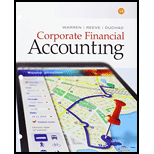
1.
Bonds: Bonds are long-term promissory notes that are represented by a company while borrowing money from investors to raise fund for financing the operations.
Bonds Payable: Bonds payable are referred to long-term debts of the business, issued to various lenders known as bondholders, generally in multiples of $1,000 per bond, to raise fund for financing the operations.
Discount on bonds payable: It occurs when the bonds are issued at a low price than the face value.
Effective-interest amortization method: Effective-interest amortization methodit is an amortization model that apportions the amount of bond discount or premium based on the market interest rate.
To prepare:
2.
A.
To prepare: Journal entry to record first interest payment and amortization of bond discount on December 31, Year 1.
B.
To prepare: Journal entry to record second interest payment and amortization of bond discount on June 30, Year 2.
3.
The amount of total interest expense for Year 1.
Want to see the full answer?
Check out a sample textbook solution
Chapter 11 Solutions
Bundle: Corporate Financial Accounting, Loose-leaf Version, 14th + CengageNOWv2, 1 term Printed Access Card
- General Accounting Question please answerarrow_forwardIncorrect Question 6 0 / 10 pts Audit Organization ABC is evaluating the different non-audit services it provides to its various clients. Indicate which of the following non-audit services would impair its independence. There are multiple answers. (Hint: There are five non-audit services that would impair the firm's independence). Hiring or terminating the audited entity's employees. Preparing financial statements in their entirety from a client-provided trial balance. Evaluation of an entity's system of internal control performed outside the audit. Approving entity transactions. Supervising ongoing monitoring procedures over an entity's system of internal control. Preparing certain line items or sections of the financial statements based on information in the trial balance. Preparing account reconciliations that identify reconciling items for the audited entity management's evaluation. Changing journal entries without management approval. Posting coded transactions to an audited…arrow_forwardFinancial Accountingarrow_forward
- Can you please solve this general accounting question?arrow_forwardThe Spice Saga has two production departments, Assembly and Finishing. Each department calculates its own predetermined overhead rate and applies manufacturing overhead throughout the year. The following information was used to calculate overhead application rates: Assembly Finishing TotalEstimated overhead $ 800,000 $ 420,000 $ 1,220,000Direct labor hours 50,000 30,000 80,000Machine hours 16,000 8,000 24,000Overhead information for Job #687 is as follows: Assembly Finishing TotalDirect labor hours 100 125 225Machine hours 30 18 48 a. Assume that The Spice Saga uses direct labor hours to apply overhead in both production departments How much overhead will be applied to Job #687? Note: Round your answer to 2 decimals.b. Assume that The Spice Saga uses machine hours to apply…arrow_forwardGeneral Accountingarrow_forward
 Excel Applications for Accounting PrinciplesAccountingISBN:9781111581565Author:Gaylord N. SmithPublisher:Cengage Learning
Excel Applications for Accounting PrinciplesAccountingISBN:9781111581565Author:Gaylord N. SmithPublisher:Cengage Learning College Accounting, Chapters 1-27AccountingISBN:9781337794756Author:HEINTZ, James A.Publisher:Cengage Learning,Principles of Accounting Volume 1AccountingISBN:9781947172685Author:OpenStaxPublisher:OpenStax College
College Accounting, Chapters 1-27AccountingISBN:9781337794756Author:HEINTZ, James A.Publisher:Cengage Learning,Principles of Accounting Volume 1AccountingISBN:9781947172685Author:OpenStaxPublisher:OpenStax College Cornerstones of Financial AccountingAccountingISBN:9781337690881Author:Jay Rich, Jeff JonesPublisher:Cengage Learning
Cornerstones of Financial AccountingAccountingISBN:9781337690881Author:Jay Rich, Jeff JonesPublisher:Cengage Learning Financial AccountingAccountingISBN:9781305088436Author:Carl Warren, Jim Reeve, Jonathan DuchacPublisher:Cengage Learning
Financial AccountingAccountingISBN:9781305088436Author:Carl Warren, Jim Reeve, Jonathan DuchacPublisher:Cengage Learning Intermediate Accounting: Reporting And AnalysisAccountingISBN:9781337788281Author:James M. Wahlen, Jefferson P. Jones, Donald PagachPublisher:Cengage Learning
Intermediate Accounting: Reporting And AnalysisAccountingISBN:9781337788281Author:James M. Wahlen, Jefferson P. Jones, Donald PagachPublisher:Cengage Learning





